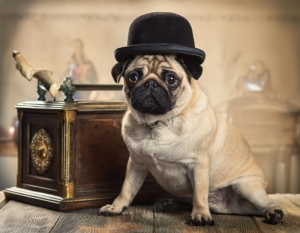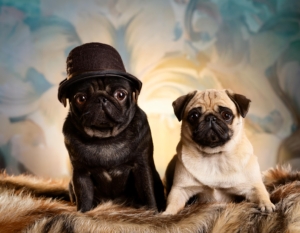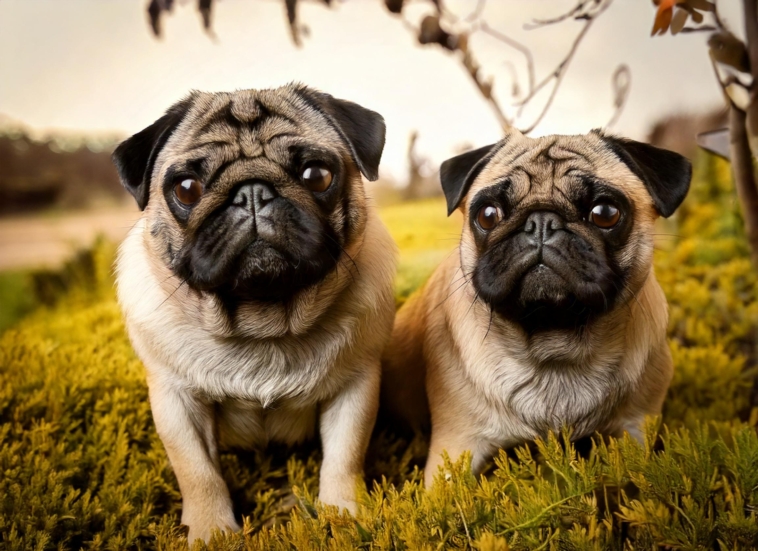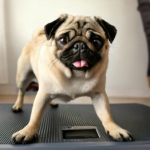Retro Pug vs Traditional Pug: The Snout-Off Showdown
The Origin Story: A Tale of Two Snoots
Pugs: China’s crinkly present to the world. But did you know there are two varieties of this smushy-nosed treat? Meet the Retro Pug, the health-focused, longer-snout cousin of the Traditional Pug, who still sports the original pancake mug like it’s the 1700s.
Where Traditional Pugs arrived with adorable but obstructed airways, Retro Pugs were selectively bred to be a throwback to their great-great-great-grandpugs—essentially, the pug equivalent of going “vintage.
Retro vs. Traditional: Face the Facts
Snout Length:
- Retro: Slightly longer nose = much more air.
- Traditional: Pretty much snorting their way through life.
Build:
- Retro: Sleek and sporty—pug yoga teacher energy.
- Traditional: Round, sturdy, for napping only.
Health Benefits:
- Retro: Less likelihood of snorting like a broken vacuum cleaner.
- Traditional: Cute, but maintenance-heavy (like your ex).
The Ancient Pug Scrolls
Pugs date way back—like, “being hand-fed grapes by emperors” back. But centuries on, dog breeders intoned: “Let’s give these wrinkled potatoes a snout so they can breathe again.”
And thus the Retro Pug was born—same adorableness, less vet expense.

Heads or Tails (Or Just Heads): Face-Off Time
- Retro Pugs: Have a snout! Less squish = fewer sneezes.
- Traditional Pugs: Face folds so deep, you might discover lost treasure in there.
Eyes:
- Retro: Eyes do exist. Just… where they’re supposed to be.
- Traditional: Eyes so googly, they’d get their own Pixar movie.
Temperament: Moody or Mellow?
Retro Pugs:
- Social, spunky, and happy for walks longer than five feet.
- Less clingy, but still game for a snuggle-and-snack time.
Traditional Pugs:
- Velcro with a heartbeat. Cute shadows with separation anxiety.
- Difficult to train unless snacks are offered. Actually, particularly when snacks are offered.
Health & Lifespan: Who Snorts Less Lives More
Let’s be real: Classic Pugs were not graced with wonderful genetics. They’re essentially wheezing the moment they’re born.
Retro Pugs:
- Breathe like regular dogs.
- Live 13–17 years (if you can keep them from snatching cupcakes).
Classic Pugs:
- Respiratory drama queens.
- Still live a good 12–15 years, provided you’ve got a vet on speed dial
Exercise: Couch Potatoes vs Energy Beans
Retro Pugs:
- Require 30–45 minutes of playtime per day or they’ll redecorate your home.
- Actually have the energy to keep up with a game of fetch.
Traditional Pugs:
- Brief walks, extended naps.
- Their patronus is a weighted blanket.
Grooming: Fluff, Wrinkles, Repeat
Retro Pug:
- Easy shedding, easy brushing.
- Less folds = less funk areas.
Classic Pug:
- Shedding like it’s a job.
- Their wrinkles require more maintenance than your plants.
Both:
- Trim nails
- ed or risk accidental shivs during zoomies.

Diet & Feeding: The Snack Crisis
Food lovers all. Like, love love. So you’d better keep an eye on those portions like it’s a Netflix marathon.
- Balanced diet = less vet guilt.
- Hydration = less vet time.
- No table scraps = less puppy eyes (good luck with that).
Training: Brain vs Belly
Retro Pugs:
- Smart cookies. Pick up quickly with a little positive reinforcement and plenty of treats.
Traditional Pugs:
- Stubborn. Sit when they feel like it, not when you command it.
- Motivation? One word: bacon.
Retro vs Traditional: Where Should They Live?
Retro Pugs:
- Flexible and globe-trotting.
- Adjust to all weather—mountain, city, suburban brunch existence.
Traditional Pugs:
- Opt for snug apartments with AC and minimal activity.
- Shun humidity or face becoming a living dumpling.
Cost of Having One of These Potato Loaves
- Retro Pugs: Greater initial cost, less medical expenses. Essentially a good investment.
- Traditional Pugs: Less expensive upfront, but prepare to donate your wallet to the vet.
Adoption or Shopping: Ethics & Expenses
- Adoption: Budget-friendly, soul-satisfying, might get lucky with a healthy mix.
- Shopping: Know what you’re getting (sort of), but watch out for shady breeders.
Either way, make sure the pupper is coming from a reputable place and not some back-alley pug deal.
In Conclusion: The Great Pug Debate
In the battle of Retro Pug vs Traditional Pug, it’s not about who wins—it’s about who snores less and eats more.
- Retro Pug: Breaths like a champ, behaves like a golden retriever in pug form.
- Traditional Pug: Classic charm with a splash of wheeze. Iconic, needy, and lovable.
Last Piece of Advice? Choose the pug that most aligns with your vibe—whether you’re a relaxed Netflix skite-watcher or someone who does downward-facing dog with your dog. Either way, you’re committing to a lifetime of snorts, snuggles, and pilfered snacks.




